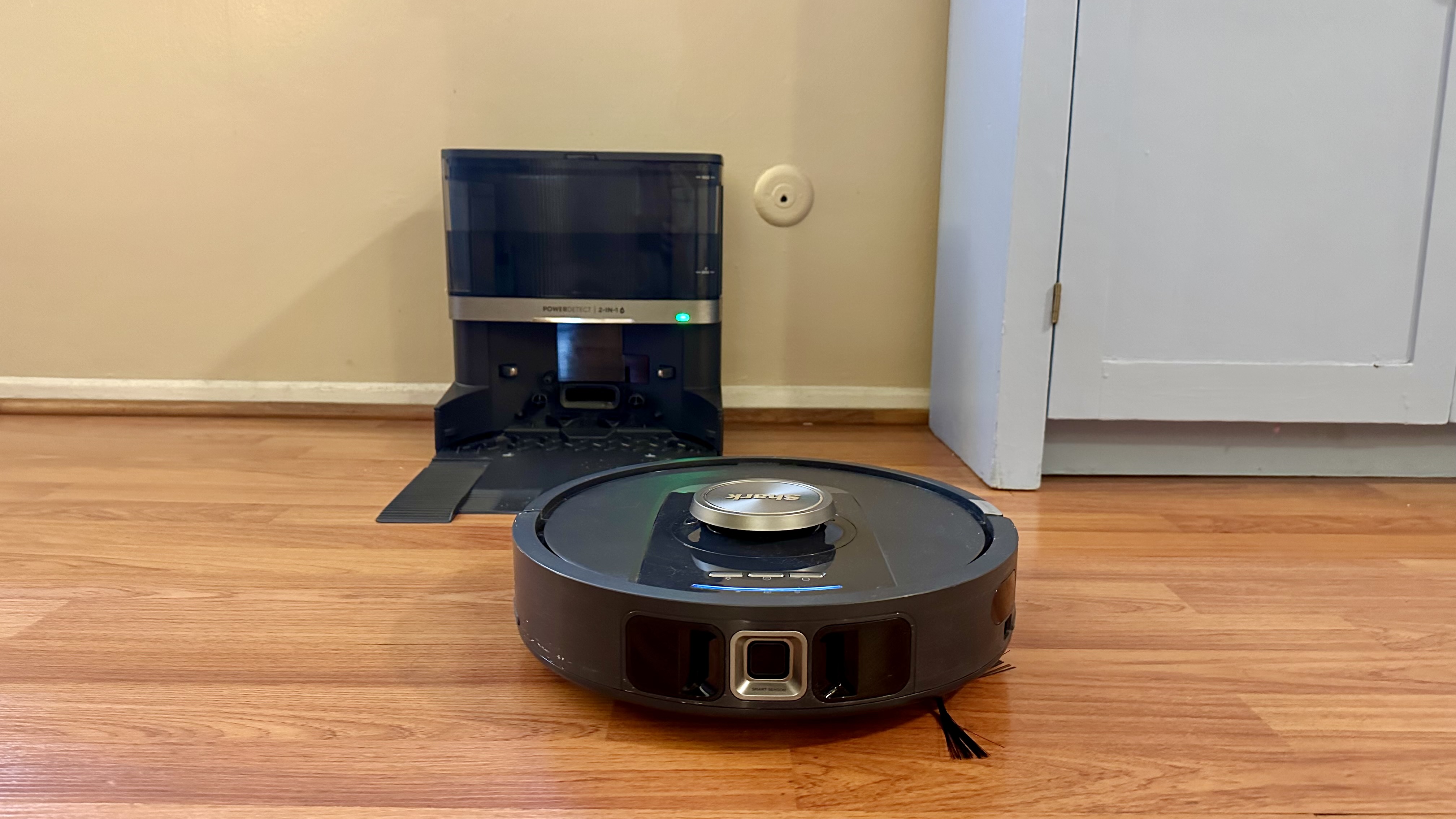The Shark name has been synonymous with quality, affordable vacuums and home products for decades, and the Shark PowerDetect 2-in-1 Robot Vacuum and Mop with NeverTouch Base continues the tradition. This midrange combo vacuums and mops your home. At the same time, the base station empties the vacuum’s dust box and fills a water reservoir, making for an almost completely hands-off cleaning experience. It’s perfect for those who are short on time and looking to keep their space tidy between deep cleans.
I tried this robot vacuum combo in my home for several weeks, seeing how it navigated and cleaned my space.
The setup was straightforward, and after connecting to the SharkClean app, a map of my home was successfully created. However, the app has some limitations compared to others I’ve tested. So, if you have a multi-story home, you may want to look elsewhere. Even with a lacking app, the robot traversed my space with ease. It rarely got stuck, even when I left tassel rugs and cords in its path. It’s some of the best navigation I’ve seen in a robot vacuum.
As for cleaning, the Shark PowerDetect performed admirably, even during more rigorous testing. It picked up large concentrations of debris like oats, rice, and sugar in just a couple of passes. The only time its performance dipped was when removing sugar granules out of a medium pile of rug and crumbs from under my kitchen cabinets. When mopping, the back-and-forth motion of the mop removed lighter spills like coffee or mud. However, more caked-on debris was left behind. Its performance was on par with other midrange vacuums I’ve tested with similar feature sets. The only major downfalls are mediocre battery life, and the vacuum suction and mopping water levels can’t be adjusted.
Luckily, the NeverTouch Base is true to its name, as I rarely had to touch it during my testing. I especially loved that Shark managed to keep compact dimensions while still packing tons of functionality into it. The station successfully emptied the robot's dust box every time and never had any issues filling the water tank. The mopping pad also lived at the base station when only vacuuming was performed with fans to dry the mop pad, successfully preventing odor.
The Shark PowerDetect 2-in-1 Robot Vacuum and Mop with NeverTouch Base is one of the best robot vacuums for those with smaller homes and light cleaning needs. It cleans up most messes and traverses spaces easily, all with just the touch of a button. Interested in grabbing this robot vacuum/base station combo? Be sure to read my full review below, where I deep-dive into the good and the bad.

Danielle Abraham is a freelance writer who spends most of her time covering tech products. You’ll find she’s written about everything from mice and wireless headphones to coffee makers and toothbrushes at some of the top publications, including IGN, TechRadar, and TopTenReviews.
She has reviewed robot vacuums from brands like Roborock, Yeedi, Eufy, and Ecovacs. In Danielle’s testing of the Shark PowerDetect 2-in-1 Robot Vacuum and Mop with NeverTouch Base, she observed its performance over several weeks in her two-bedroom, two-bathroom apartment that consists of hard laminate floors and rugs.
Shark PowerDetect 2-in-1 Robot Vacuum and Mop with NeverTouch Base: Key specs
| Type | Robot |
| Battery Life | ~ 1.5 hours |
| Charging time | ~ 3 hours |
| Filtration System | HEPA Filter |
| Dust Box Capacity | 0.33 qt |
| Vacuum Dimensions | 14 x 3.9 inches |
| Base Dimensions | 19 x 13.4 x 14.3 inches (L x W x H) |
| Mopping Capability? | Yes |
| Self emptying? | Yes |
Shark PowerDetect 2-in-1: Price & value
The Shark PowerDetect 2-in-1 Robot Vacuum and Mop with NeverTouch Base retails for $899.99 but is often on sale for significantly less. At the time of this writing, it was available directly from Shark for $549.99 and can be found at retailers including Amazon and Target.
If you can grab this robot vacuum and base station combo on sale, it’s a solid option. It performs double duty with vacuuming and mopping, while the base makes everything more hands-off. The midrange price is comparable or lower than other robots with similar feature sets. Plus, the base station differentiates itself from many other robot vacuums with its bagless, self-emptying base, making maintenance even easier (and cheaper).
You also have the option to upgrade to the NeverTouch Pro Base to get mop pad washing in addition to the auto-emptying and self-refilling available with the Never Touch Base. However, I think it’s not worth the significantly higher cost.

Shark PowerDetect 2-in-1: Setup
The Shark PowerDetect 2-in-1 Robot Vacuum and Mop with NeverTouch Base came in a smaller-than-expected box that was easily manageable all by myself. After opening the shipping box, I was greeted with another colorful box full of information regarding all the features. Inside that box, I found a large card with instructions for a quick setup. Under the card were the robot vacuum and base station’s components; the box perfectly fit the contents. Although some plastic bags were used in the packaging, I was pleasantly surprised that cardboard kept the components safe rather than styrofoam, making it slightly more environmentally friendly.
The box included the robot vacuum, NeverTouch base, ramp, two side brushes, an extra mopping pad, Odor Neutralizer Cartridge, and mop cleaning solution. Luckily, it’s not an overwhelming amount of products. However, I did seem to be missing a side brush; it’s not a huge deal and could’ve just gotten accidentally tossed. Still, everything looked pristine, and I was excited to try out this vacuum.
Set-up is fairly straightforward, and the instruction card walked me through the process with handy visuals. I placed the NeverTouch base on a flat, hard surface with plenty of open space and access to a power outlet. Putting everything together was on par with many other robot vacuums I’ve tested. The Odor Neutralizer Cartridge and bagless dust bin on the base station were the only real unique features. It took around five minutes for the robot vacuum to be in the base station charging, preparing for its first clean.
After preparing the components, I connected the robot to Wi-Fi using the SharkClean app. I already had an account, but creating one only takes a few minutes. From there, the app walked me through connecting the robot to Wi-Fi. In my first attempt, the robot wouldn’t connect. Luckily, the app gives you scenarios to fix the problem, and on the second attempt, the robot is connected.
When the vacuum charged up to 100%, I sent it out on its maiden voyage. Although it vacuums and mops, it only vacuums when doing the initial mapping of your home. Unfortunately, after the first map is created, the robot needs to go back out again to note carpeting and rugs, which I found annoying. But when that’s finished, the Shark PowerDetect is ready to vacuum and mop your home.
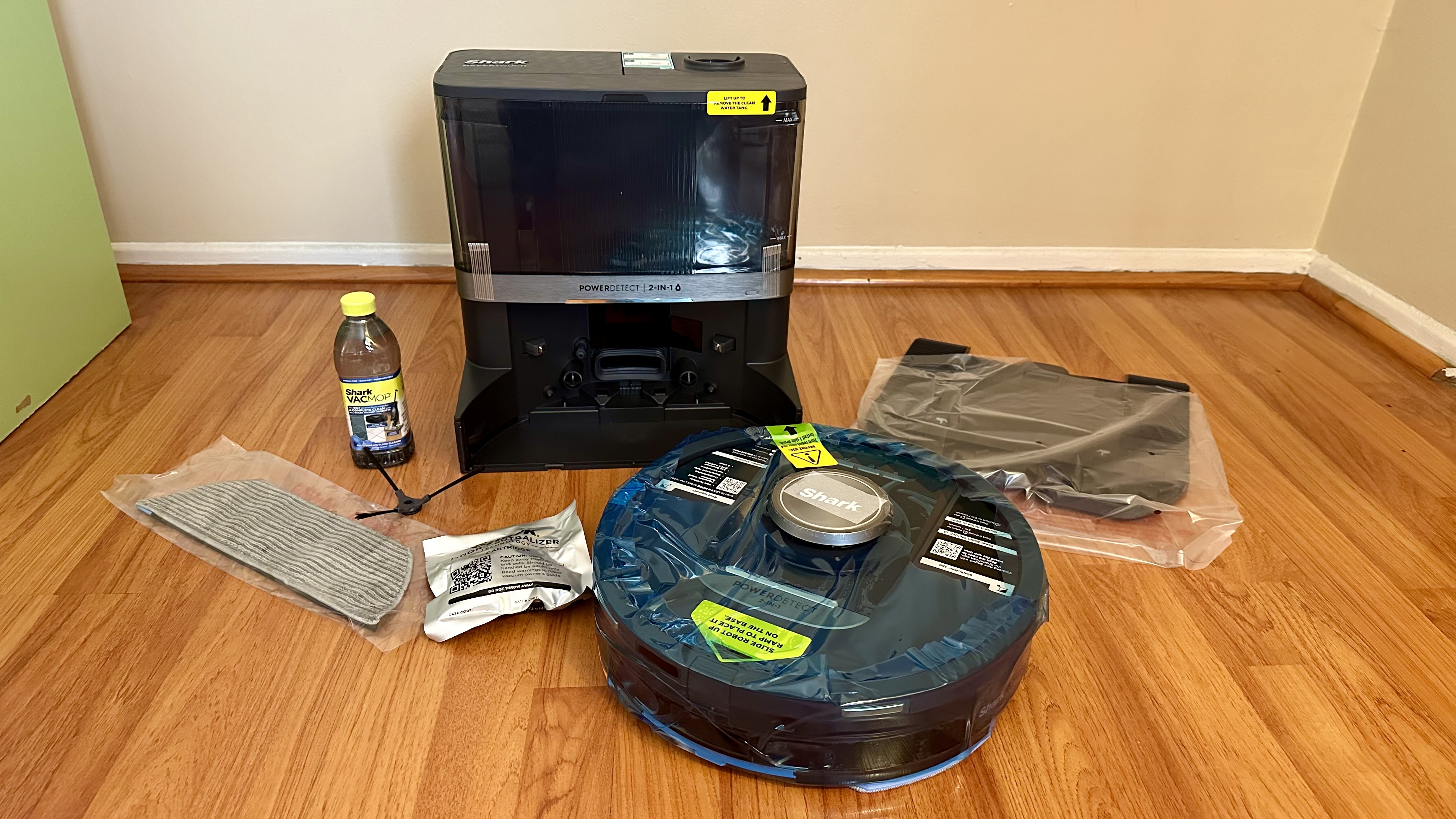
Shark PowerDetect 2-in-1: Design & features
The Shark PowerDetect 2-in-1 Robot Vacuum has a design similar to most robot vacuums, with a sleek grayish-black color scheme that should go well in most spaces. However, after the first cleaning, it was already full of scuffs and scratches, and dust became visible on it after only a few days as well.
Its circular shape has a diameter of about 14 inches and a height of 3.9 inches, which makes it a little too tall to fit under furniture like couches. Still, it had no trouble reaching under a bookshelf and lounge chair. But its height became a major problem under the lip of my kitchen cabinets, making the EdgeDetect cleaning feature that’s advertised pretty useless in the most needed area of my home. After every cleaning, the crevices were still littered with crumbs.
On top of the robot are three buttons for control and a lovely LED strip that glows colors with different effects to indicate battery levels, problems, cleaning modes, and more functions. The three buttons include one for dry vacuuming your home, another for mopping and vacuuming, and a final one that sends the vacuum home. In testing, each of these buttons worked exactly as expected. It was all fairly straightforward, given the limited button options. However, the app is needed to select certain rooms, schedule cleanings, and make other customizations.
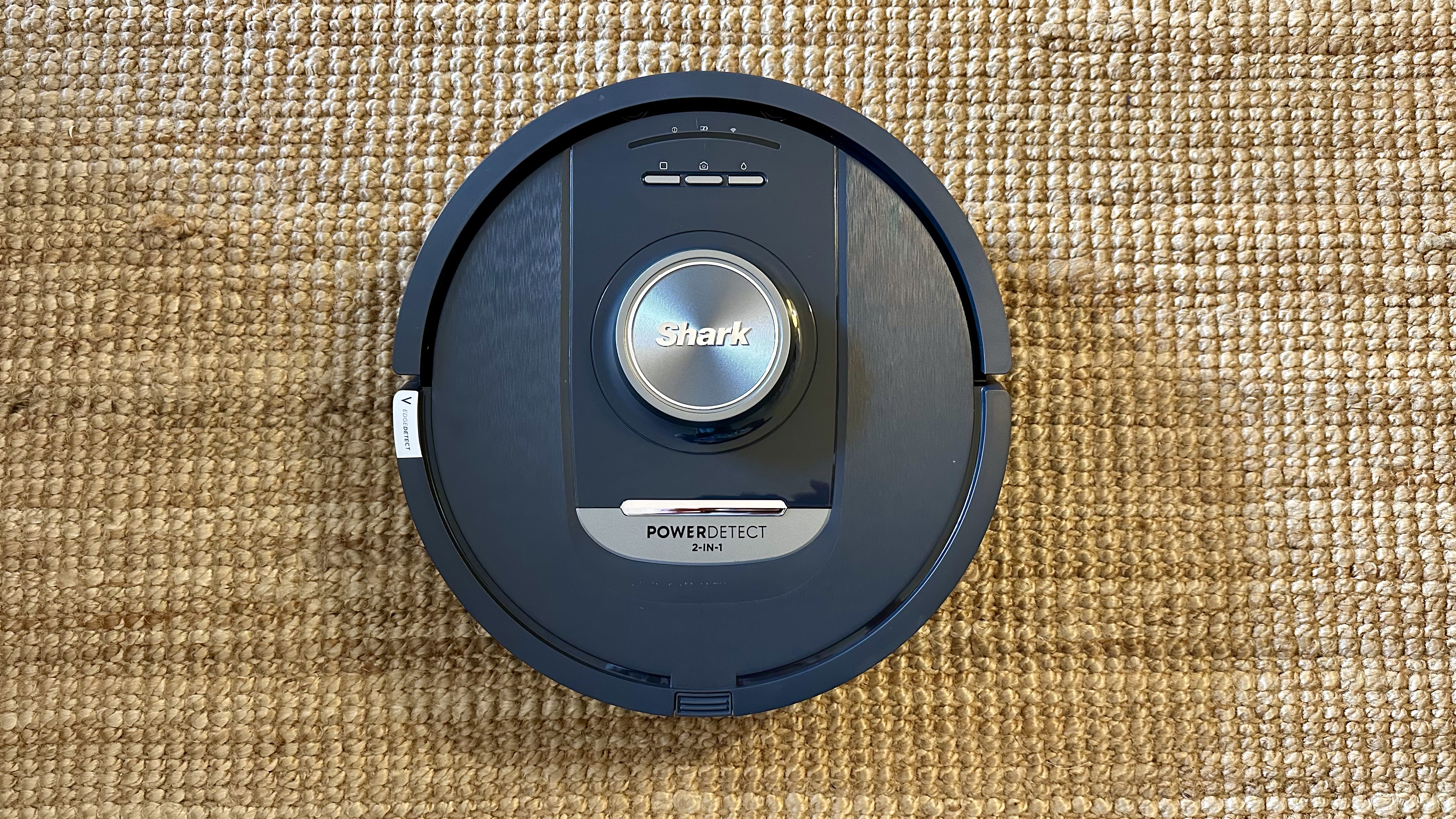
Speaking of the app, the Shark Clean app is severely lacking compared to apps from other robot vacuum manufacturers. Sure, it does the basics fine, but forget about creating multiple maps, adjusting the vacuum suction level, changing the mop water levels, and checking on the life span of components.
On the underside of the vacuum is a 5.69-inch cleaning path with a main roller that tends to wrap hair, so regular cleaning is necessary. A side brush helps to move stray debris into the cleaning path. Large back wheels also lift the backside of the vacuum pretty high, aiding in the NeverStuck technology.
The most unique feature is the mopping pad component, which automatically detaches from the robot and lives in the base station while the robot is performing vacuuming tasks. The base station even features a quiet fan to dry the mopping pad, preventing odors during my testing. Unfortunately, the station doesn’t wash the mopping pad like some more advanced offerings.

In addition to housing and drying the mopping component, the NeverTouch Base automatically empties the robot’s 0.33 qt dust box into its bagless dust bin, ready to hold up to 60 days of dirt. It’s rare to find a robot vacuum base station with no bag, so avoiding the extra expense of replacing the bags down the road is nice.
Like most of Shark’s vacuum lineup, the base also features an Odor Neutralizer Cartridge. It’s a pointless gimmick that smells nice for about one minute after the robot is emptied into the base but serves no real purpose. It’s an item I’d never replace after it runs out.
The base station’s compact size is my favorite feature, measuring 19 x 13.4 x 14.3 inches. It’s great for those with limited space. I was shocked by how much capability Shark managed to pack into it.
Of course, the vacuum also charges at the NeverTouch Base. During my testing, the vacuum would take around three hours to charge back to full from 15% battery, which is average. Without fail, when the robot vacuum hit 15% battery, it would return to the base. When completing vacuuming and mopping tasks, I found the robot would last about an hour and a half before reaching 15%. Unfortunately, this was never enough time to fully clean my two-bedroom, two-bathroom apartment. The robot does pick up where it left off after it finishes charging. Its battery life is acceptable, but I’ve seen better. Still, those cleaning smaller spaces should find the battery life sufficient.
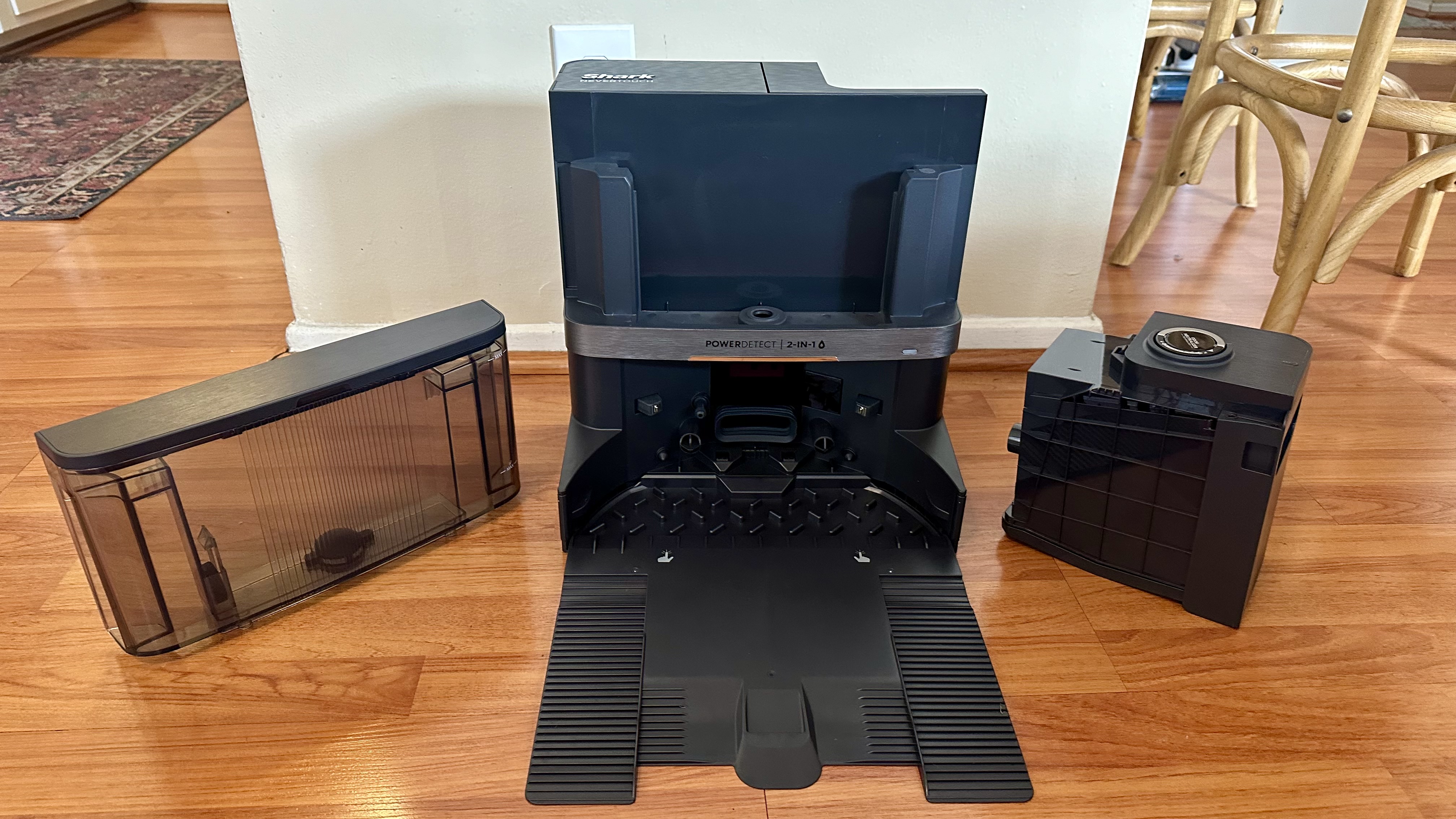
Perhaps most importantly, how noisy is the robot vacuum? I’m happy to report it measured at only about 65dB. I’d compare it to the noise of a window air conditioner. I noticed it initially, but it’s just a quiet hum that quickly becomes background noise. I could work and watch TV as it went around my space. When the mopping pad was attached, there was a slight clicking of the pad going back and forth, which was a little more distracting, and the wheels occasionally squeaked on the wet floor. As someone who is extremely noise-sensitive, I could ignore it. The only time I was startled by the robot was when the vacuum emptied into the base station, hitting closer to 75dB–about the same level as your average corded vacuum cleaner.
Shark PowerDetect 2-in-1: Performance
The Shark PowerDetect’s first vacuuming of my home created a map of my space. The initial map was accurate, but most rooms needed to be adjusted by adding walls and no-go zones. Still, almost every spot of my space was accounted for on the map. It was slightly annoying that I had to send it out again to make notes of carpet and rugs before it would mop. I feel this should’ve been done during the initial mapping. After the second mapping, my rugs and a few pieces of larger furniture were accurately noted.
Whenever I selected specific rooms or spots to be cleaned in the app, the robot managed to get to the space and clean it without fail. I was impressed, especially considering a robot vacuum I tested a few months ago, which cost almost three times as much, would constantly get lost and go to the wrong rooms. However, communicating with the robot through the app during a cleaning was a hit-or-miss. I tried to pause it and send it home several times, but nothing happened.
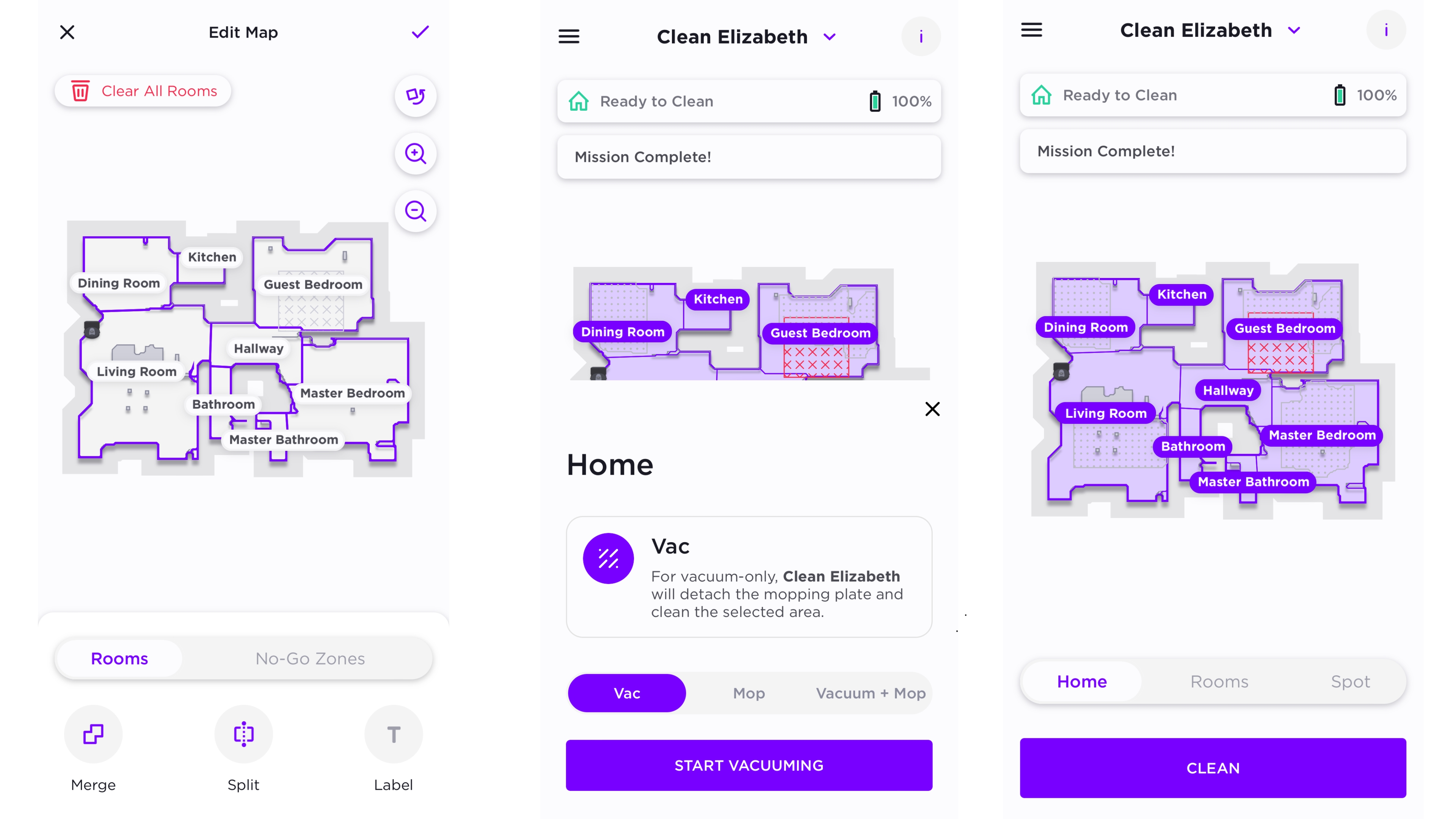
Watching the Shark PowerDetect traverse my home, I noticed it did a great job covering almost every inch of space as best it could. As I mentioned, it’s EdgeDetect technology wasn’t the best. So, some debris didn’t get picked up closer to walls and obstacles.
When it came to larger obstacles like chair legs, dressers, and other furniture, the vacuum got relatively close and usually avoided running fully into them. On occasion, it did ram into a few things. As for smaller obstacles, like a hand weight or sock that I placed directly in its path, sometimes the Shark PowerDetect would back away and completely avoid it, while other times it’d tap and attempt to push the object out of the way.
Though it’s generally best practice to remove cables, looser rugs, and random items like clothes and shoes out of the way of any robot vacuum, I wanted to see how the vacuum faired when dealing with these everyday obstacles. It got tangled in a few cables and rolled up some rugs, but the robot freed itself each time without my intervention. I noticed the backside lifted quite high, which helped. Nothing even got stuck in the main brush (other than hair wrapping around). Shark’s NeverStuck technology was quite impressive.
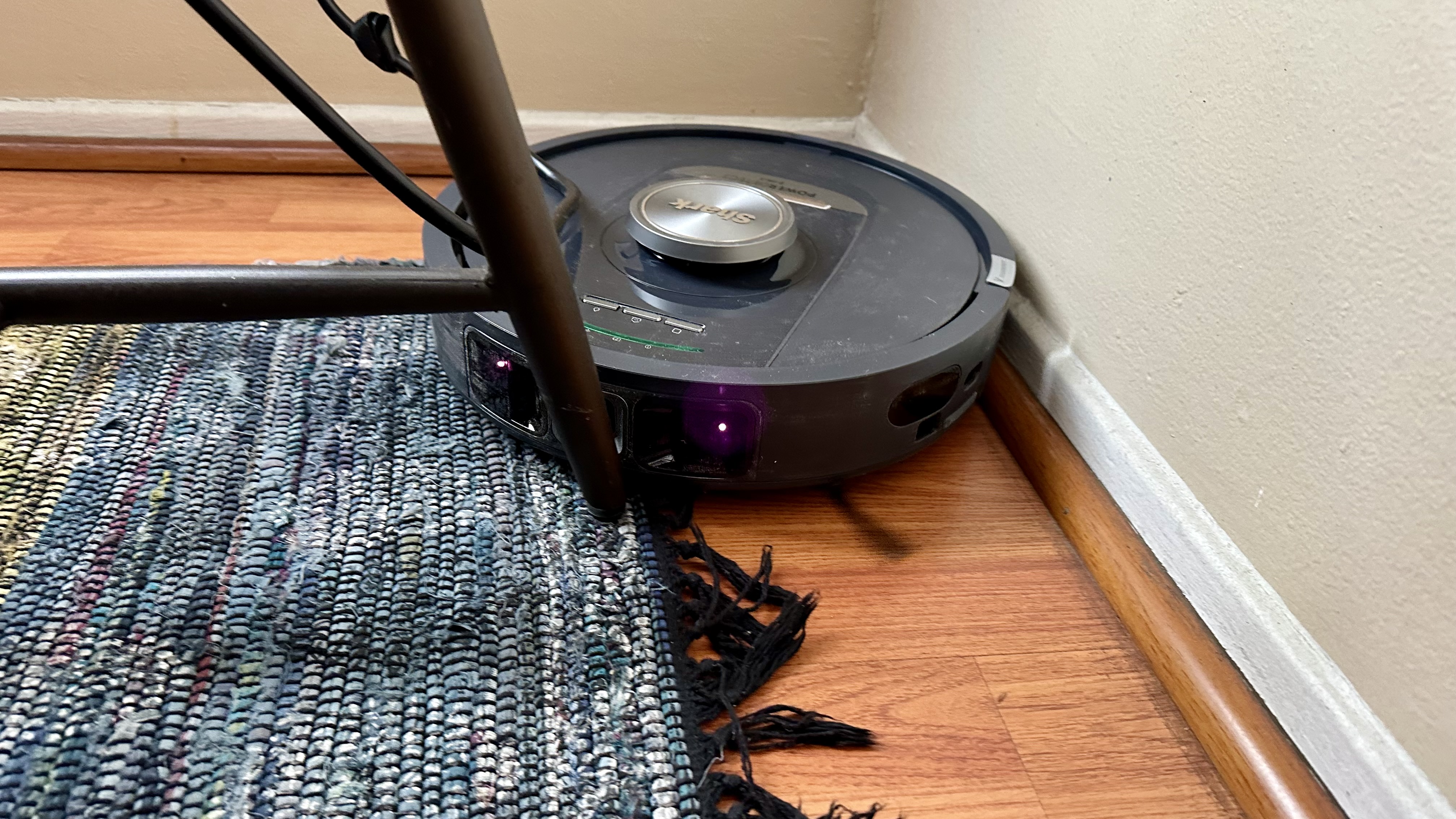
In my three weeks of testing, I needed to assist with the robot vacuum only twice. Once, it lifted itself onto the leg of my standing desk, and another time, it couldn’t dock into the base station. Even out of the dozen or so robot vacuums I’ve tested, the Shark PowerDetect proved to be one of the best at navigating a cluttered space.
The Shark PowerDetect’s navigation is solid, and luckily, so is its cleaning performance. During average vacuuming tasks, it managed to pick up almost all debris in its path. Mopping was equally great. The mopping pad will swing back and forth for a good scrubbing action. Although, I think oscillating mopping pads work best for the deepest clean. Still, the mop cleaned mud stains and coffee spills like a champ. More caked-in food and messes remained, but it's perfect for lighter messes and dust.
It’s important to note that when you want to mop and vacuum your entire home, the robot will first vacuum all the carpets and then come back to add the mopping component. Cleaning takes more time than with other robot vacuums I’ve tested, as most just lift the mopping pad when going over rugs and carpets. At least the vacuum was excellent at recognizing a rug versus a hard floor.

Beyond everyday cleaning, I did more rigorous vacuum testing on hard floors and rugs using a heavy concentration of oats, rice, and sugar. First, I spread the oats around my laminate floor and sent the vacuum for a spot cleaning. During the initial pass, some oats were picked up while some were thrown about – mostly due to the side brush. Luckily, the vacuum automatically returned and did a second pass-through, which picked up almost everything. The vacuum performed similarly with both rice and sugar on the hard floor.
As for testing on a medium pile rug, the oats and rice were almost fully picked up after a second pass-through. However, a good chunk of the sugar granules got ingrained in the rug and left behind even after multiple cleanings. These results aren’t dissimilar to other robot vacuums. So, if your space is mostly carpeted, a regular corded vacuum with more suction power is usually your best option.
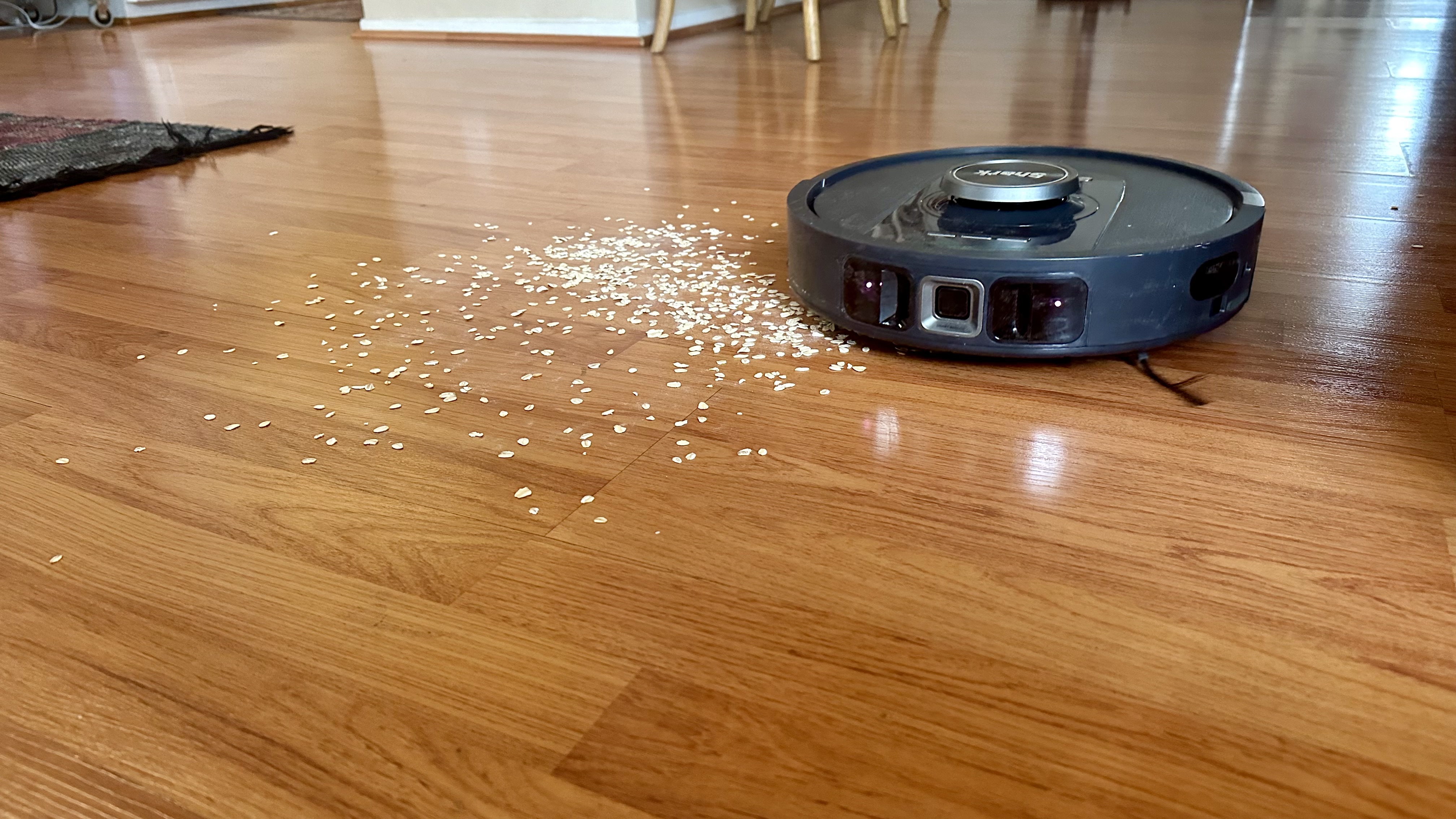
After each cleaning or when the dust box got full during cleaning, the robot emptied into the NeverTouch Base. I checked the robot's dust box after emptying, and it successfully removed all the debris. The water reservoir on the base station also automatically filled the vacuum tank. After three weeks of use, that water tank is still half full. Therefore, the “NeverTouch” technology is very true to its name.
The maintenance is minimal. When I emptied the dust bin on the base and filled the water reservoir, it took all of one minute. Down the road, some filters, brushes, and the mopping map will need to be replaced–something that happens with every robot vacuum. But for the most part, cleaning your home is hands-off other than pressing a button on the robot or your app.
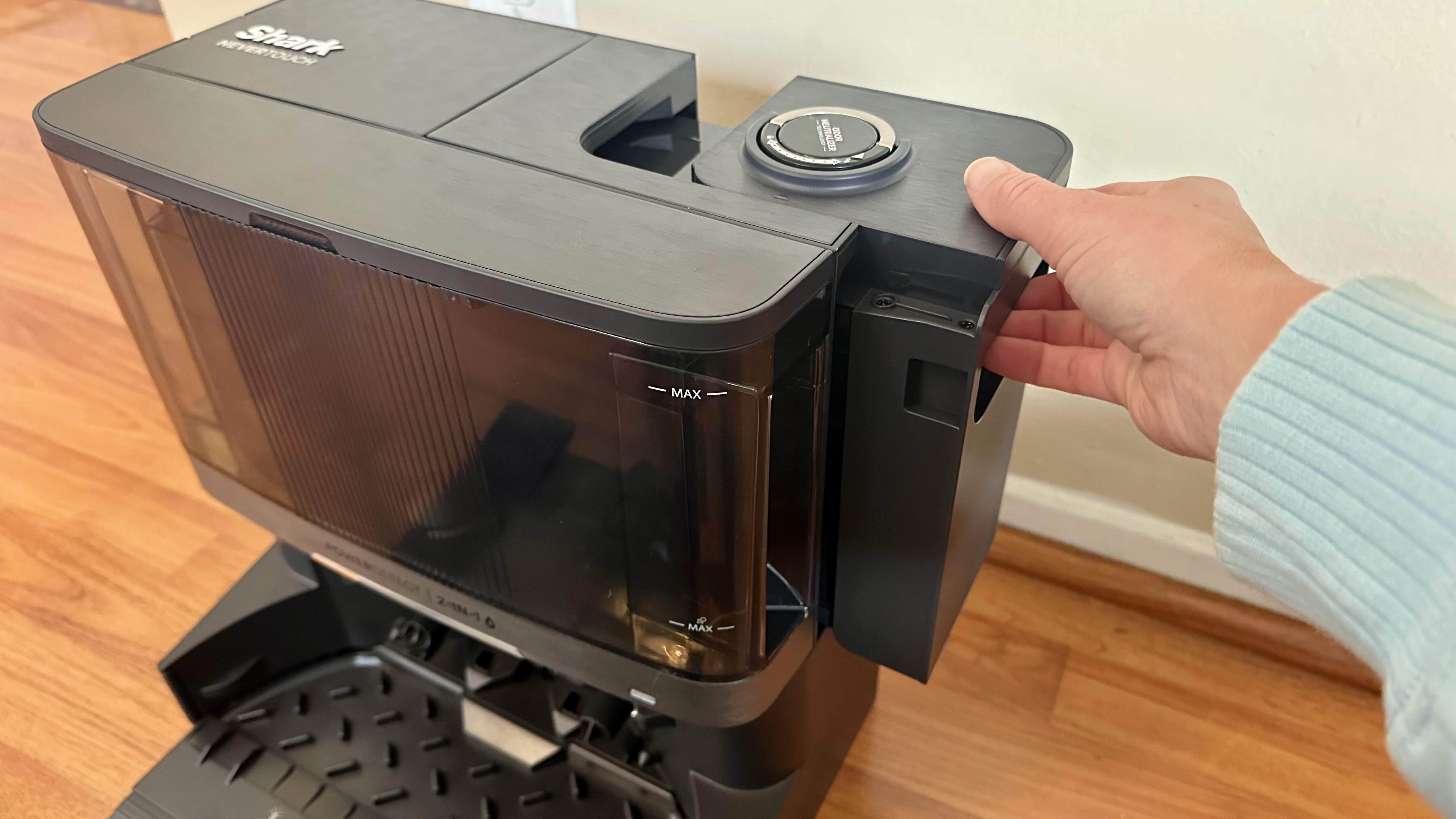
Would I buy the Shark PowerDetect 2-in-1 Robot Vacuum and Mop?
| Attribute | Notes | Score |
|---|---|---|
| Ease of Use | Easy setup; simple on-vacuum controls work as expected; base station consistently empties dust box and fills water reservoir; lackluster app | 8/10 |
| Battery Life | Battery only lasts about 1.5 hours – not enough time to complete a whole home cleaning of my space; recharge time takes about 3 hours, which is average | 7/10 |
| Maneuverability | Easily traverses space; rarely gets stuck and can usually free itself; doesn't get too close to edges; good obstacle avoidance | 8/10 |
| Suction Power | Enough suction to pick up heavy concentrations of debris on hard floors after a couple passes; picks up most debris on carpets; can't adjust suction power | 8/10 |
| Maintenance | Base station empties dust box on robot, fills water tank, and dries mopping pad; dust bin holds up to 60 days of dirt, hair wraps around main brush; components will need replacement | 9/10 |
Buy it if...
Don't buy it if...
How does the Shark PowerDetect 2-in-1 compare?
The Shark PowerDetect 2-in-1 Robot Vacuum and Mop with NeverTouch Base is similar to the Shark Detect Pro Self-Empty Robot Vacuum I reviewed in 2023. The latter is an excellent option for someone who doesn’t want the mopping functionality offered on the PowerDetect 2-in-1. Plus, it’s significantly less expensive. At the time of writing, it’ll set you back about $200 less. Even without the mopping functionality, the Detect Pro still has a bagless, self-emptying base station similar to the DirtDetect Technology of the PowerDetect. However, I found the navigation and object detection slightly less impressive on the older model.
If you’re after a feature set and price similar to the Shark PowerDetect 2-in-1 from a different brand, I tested the Yeedi Cube, and it may be for you. It comes with vacuuming and mopping features, but the base station cleans the mopping pad. You don’t need to worry about washing the mopping pads yourself. The Cube’s battery life also outdoes the Shark’s for extended cleaning time.
For those with an unlimited budget looking to take the Shark PowerDetect 2-in-1 Robot Vacuum and Mop with NeverTouch Base’s features to the extreme, I reviewed the Ecovacs Deebot X2 Combo. Its base station towers over Shark’s and costs almost three times as much but has everything you can think of, including an attached handheld vacuum that empties into the base station and mop cleaning station. The robot vacuum itself comes with oscillating mops and even a camera. Plus, the Ecovacs app is far superior to the SharkClean app.
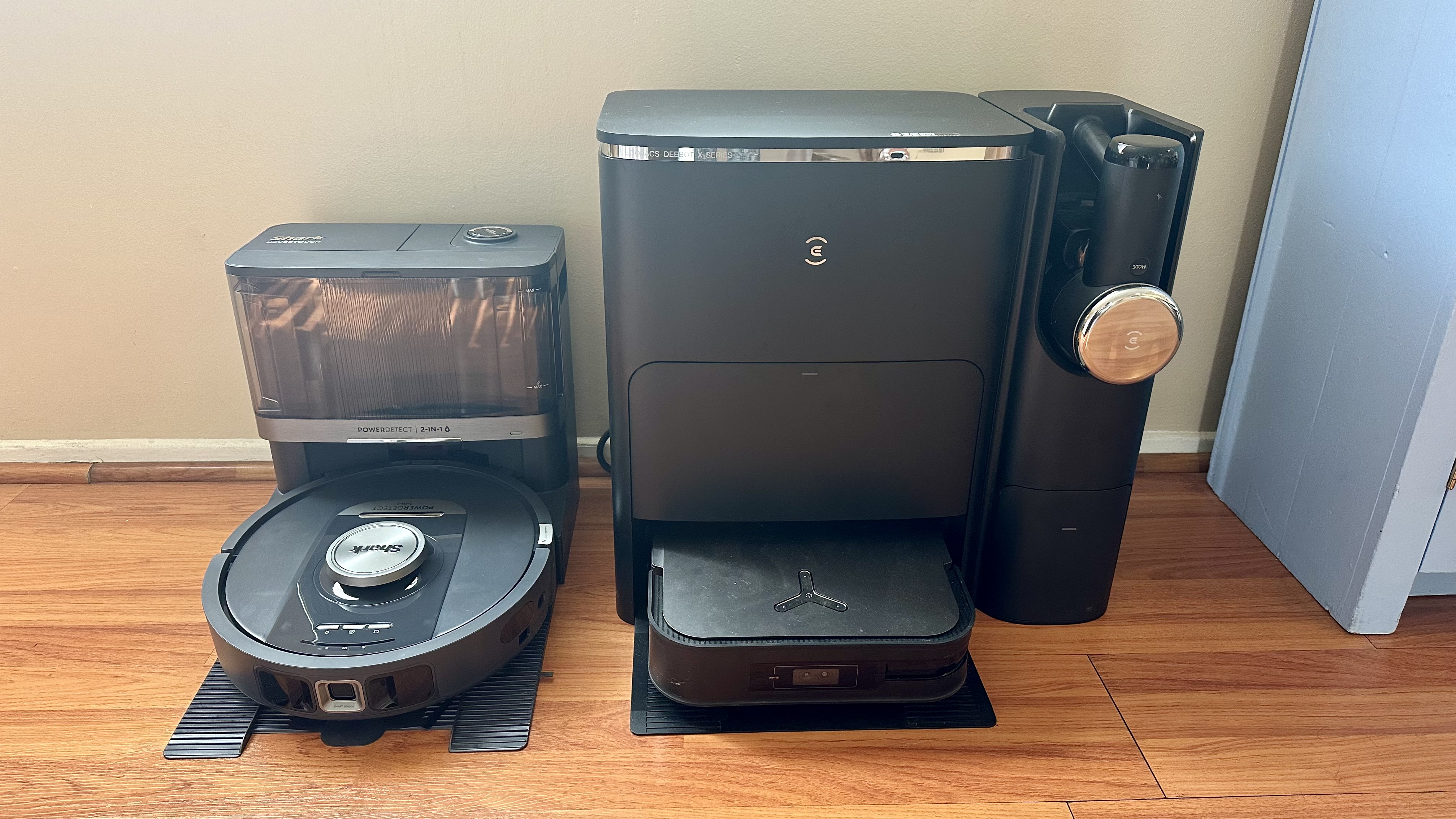
How I tested the Shark PowerDetect 2-in-1
I reviewed the Shark PowerDetect 2-in-1 Robot Vacuum and Mop with NeverTouch Pro Base in my two-bedroom, two-bathroom home over several weeks, sending it out often for full home vacuuming and mopping along with smaller tasks like certain rooms or spot cleaning. My floors consist of hard laminate with various low pile and tassel rugs scattered throughout. Beyond vacuuming everyday debris like dust, food crumbs, and hair, I also put it through more rigorous tests with larger concentrations of oats, rice, and sugar. A dB meter app on my phone allowed me to measure noise levels during usage.
Learn more about how we test.
